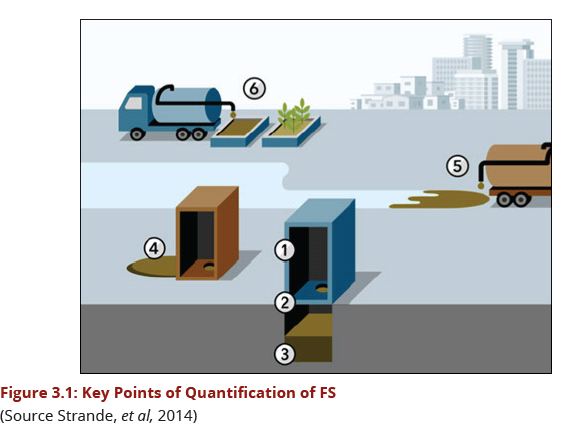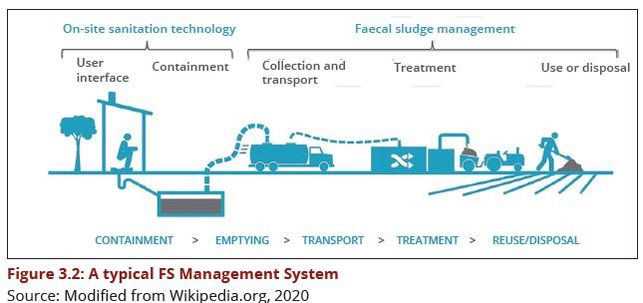Chapter Three: On-Site Sanitation Systems
Contents
1 Chapter Three: On-site Sanitation Systems
1.1 3.1 INTRODUCTION
Sanitation refers to the prevention of people from coming into contact with wastes generated in homes, workplaces and public buildings, by providing facilities and services for the safe management of human excreta to containment and storage and treatment on-site or conveyance, treatment and eventual safe end use or disposal (https://www.who.int/topics/sanitation/en/). On the basis of the transport and treatment mode, there are two main types of sanitation systems, namely; on-site sanitation (OSS) and off-site sanitation systems. Under the off-site system, there are two sub-categories of centralized and Decentralized Wastewater Treatment (DEWAT). This manual provides guidance for the design of both types of systems. This chapter focuses on OSS.
1.2 3.2 FAECAL SLUDGE MANAGEMENT (FSM)
In Tanzania, it is estimated that about 90% of the population is served by OSS and technologies which include pit latrines, septic tanks and soak-away pits (Brande et al, 2015). These systems end up generating huge volumes of faecal sludge (FS) which accumulates in on-site sanitation management technologies.
‘Faecal Sludge (FS) is defined as the raw or partially digested, a slurry or semisolid material resulting from the collection, storage or treatment of a combinations of excreta and black water, with or without grey water. Examples of on-site sanitation technologies include pit latrines, un-sewered public ablution blocks, septic tanks, aqua privies, and dry toilets. FSM includes the storage, collection, transport, treatment and safe end-use or disposal of FS. FS is highly variable in consistency, quantity, and concentration.
Recently, FS has presented itself to be one of the major sanitation management challenges in urban areas of Tanzania. This calls for adequate and appropriate FSM.
To better address FSM challenges, it is important to consider FSM as a sanitation service delivery chain. In a developing country settings FSM refers to organized programmes that provide safe and hygienic septic tank and pit latrine emptying services, along with the proper treatment of liquids and re-use of related bio-solids where possible. Adequate and proper FSM follows a ‘service chain’ approach. The service chain includes the collection, storage, transport, treatment and safe enduse or disposal of FS. FS quantity which is an important element in design of FS treatment facility is determined as depicted on Figure 3.1.
The complete sanitation service chain is shown in Figure 3.2. The FSM component is specifically the emptying, collection, transport, treatment and end-use or disposal of FS. This design manual provides a framework for the design of sanitation systems in all its components of sanitation service delivery chain.
1.2.1 3.2.1 Quantification of FS
Deriving accurate estimates for the volume of FS produced in an area is essential for the proper sizing of infrastructure required for the relevant collection and transport networks, discharge sites, treatment plants, and end-use or disposal options. The first step in designing FS (FS) treatment technologies that will meet defined treatment objectives. This will quantify and characterise the FS to be treated. Ideally, this should be carried out as part of the feasibility study.
Accurate estimate of FS volume is crucial for the appropriate sizing of collection
and transport systems, treatment facilities, discharging sites and disposal
options. While methods for quantification of FS are still being evaluated globally,
the following key points have been applied in the quantification of FS:
(a) The amount of excreta going into the toilet depending on how many people
eat and excrete in a location,
(b) How much FS is produced in addition to toilet paper and flush water to the
previous number,
(c) The amount of FS accumulated by balancing accumulation and degradation
(currently it is done empirically),
(d) The amount emptied from the containment,
(e) The amount that is illegally discharged,
(f) The actual amount delivered to the treatment plant
Additionally, Figure 3.1 should be used together with the shit flow diagram
presented in Figure 3.3 to estimate the quantity of FS.
Due to the variability of FS volumes generated, it is important to make estimates based on the requirements specifically for each location and not to estimate values based on literature. For example, from the FS quantification diagram, bullet six will be obtained from the number of trucks and their capacity. Then from the shit flow diagram, this amount is equal to 11%. So, the total quantity of FS generated is (quantity at point 6/0.11).
However, no proven methods exist for quantifying the production of FS in urban areas, and the data collection required in order to accurately quantify FS volumes would be too labour intensive, especially in areas where there is no existing information.

